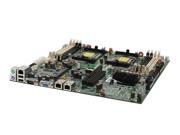There's currently a great deal on a dual processor motherboard on Newegg.com so if you're looking for a dirt cheap 1u server and willing to build your own server. For a single cpu setup with 8 gigs of ram and 1 hard drive in a 1u non hot swap chassis the components are less than $600. Here's the components you will need:
The base of this build is the TYAN S2912G2NR server mother board, which is currently selling for $69.99. The board officially supports 2 Dual Core AMD Opteron processors but some people have gotten it to work with some of AMD's new Quad Core processors, though it's not officially supported and may cause you problems with certain power management features. There are 8 240 PIN DDR2 667 memory slots for up to 64GB of RAM if you're using two processors. The board only supports PATA and SATA II drives but you can hook up 6 of them with the onboard controller and select RAID 0/1/0+1/g and JBOD.
The reason the motherboard is so cheap is because it is being EOL'd. Likely because of the problems with quad core processors. If 4 cores (2 dual core CPUs) is good enough for you, then this is a great deal. The S2912 board is being replaced by a new model that has support for the Barcelona and Shanghai Opteron CPUs.
Tyan Thunder n3600R (S2912-E) Server Board - nVIDIA - Socket F (1207) - 1000MHz HT - 64GB - DDR2 SDRAM - Extended ATX
Dual Core Opteron
If you want to be safe, the Dual Core Santa Rosa processors are a good fit for this board. Below is a selection of processors that will work with this board along with current prices (as of today):
- $129.99 -
AMD Opteron 2210 1.8GHz Socket F 95W Dual-Core Server Processor
-
$139.99 -
AMD Opteron 2212HE 2.0GHz Socket F 68W Dual-Core Processor
-
$149.99 -
AMD Opteron 2214HE 2.2GHz Socket F 68W Dual-Core Server Processor
-
$164.99 -
AMD Opteron 2222SE 3.0GHz Socket F 119W Dual-Core Processor
CPU Cooler
This motherboard has a 4.1" mounting pitch which is less common. So you need to make sure you pick the right heatsink. A good one for this board is the
Thermaltake 1U CPU Fan - 70mm - 4800rpm - 1 x Ball Bearing, 1 x Sleeve Bearing
Memory
You'll need a minimum of 2 sticks of ram per processor. 4GB DDR2 Ram is affordable enough to use these days at around $80/stick.
Kingston 4GB 240-Pin DDR2 SDRAM Server Memory Model KVR667D2D4P5/4G
is a good choice to use with this board.
Hard Drives
For servers in a raid configuration, I like Western Digital RE3 Drives. Below are options you can use with this board.
- $69.99 -
Western Digital RE3 250GB 3.5" SATA 3.0Gb/s Hard Drive
- $79.99 -
Western Digital RE3 320GB 3.5" SATA 3.0Gb/s Hard Drive
- $89.99 -
Western Digital RE3 500GB 3.5" SATA 3.0Gb/s Hard Drive
- $139.99 -
Western Digital RE3 750GB 3.5" SATA 3.0Gb/s Hard Drive
- $159.00 -
Western Digital RE3 1TB 3.5" SATA 3.0Gb/s Hard Drive
1u Chassis
If you don't care about having hot swap drives, the
NORCO RPC-170 Black 1U Rackmount Server Case
is a good deal at $79.99. You'll also need an
Athena Power AP-U1ATX40L 1U 400W Server Power Supply
at around $95.
Hot Swap Chassis
Because of the size of the motherboard, options are limited for hot swap chassis. Chenbro has a 2U chassis that will support 4 Hotswap 3.5" Drives. The chassis includes a power supply.
Alternately, you can go with 4 2.5" hot swap drives in this 1U chassis from Athena Power which includes a 500W power supply. For a raid setup, the 2.5" Velociraptor 10K drives are very good and provide better performance than the 3.5" Drives. Not quite SAS but pretty darn close. They're a bit pricey but great for disk heavy applications such as databases. They are available in 2 different capacities, 150GB and 300GB. Put them in a RAID 1+0 configuration, or a mirrored pool if you're using ZFS and you'll get 300GB or 600GB of capacity and incredible performance.
-
WD VelociRaptor WD1500BLFS - Hard drive - 150 GB - internal - 2.5" - SATA-300 - 10000 rpm - buffer: 16 MB
-
VelociRaptor 300GB Internal 2.5 SATA Hard Drives
Sata Cables
The position of the SATA ports on the board is a bit awkward. The included 18" SATA cables that come with the motherboard won't reach drive bays that are on the right hand side of the chassis. For this reason you should pick up some
OKGEAR 36" SATA ll Cables
depending how many drive's you'll be using.
